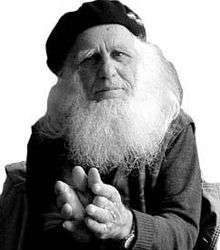Gheorghe Briceag
| Gheorghe Briceag | |
|---|---|
 | |
| Born | 15 April 1928 |
| Died | 16 August 2008 (aged 80) |
| Nationality | Moldovan |
| Known for | Soviet dissident, human rights activist |
| Awards | Homo Homini Award (2004) |
Gheorghe Briceag (15 April 1928 – 16 August 2008) was a Moldovan human rights activist notable for his opposition to Soviet rule.[1] In the 1940s, Briceag was given a ten-year sentence in the gulag for distributing anti-communist flyers; he was forced to work in coal mines for the length of his sentence. His prisoner number was "P169". After his release, he was sentenced to seven more years of exile.[1] He later became a symbol of resistance to Soviet occupation of Moldova.[1]
In 2004, Briceag won the Homo Homini Award of the Czech NGO People in Need, which recognizes "an individual who is deserving of significant recognition due to their promotion of human rights, democracy and non-violent solutions to political conflicts".[2] The award citation described him as "a life-long activist for the defense of human rights and the defense of other former Gulag prisoners in Moldova".[2] The following year, he served on the Rudolf Vrba Jury for People in Need's One World International Human Rights Documentary Film Festival, serving with fellow Homo Homini-winner Ales Bialacki.[3]
The same year, Briceag created controversy by opposing the re-installation of a statue of Vladimir Lenin in his hometown of Bălţi. Briceag threatened to burn the statue down personally if it were completed.[4] The Supreme Court of Moldova ultimately overruled the Bălţi City Council's decision to allow the statue.[3]
Briceag also worked with Amnesty International[1] and served as the Bălţi coordinator of the Helsinki Committee for Human Rights.[5]
Briceag was noted for his large "Solzhenitsyn-style" beard.[4] A few months before his death, he pledged to shave it if Moldova united with Romania,[4] a move Moldova's communist party opposed.[6] He publicly requested that his body be donated to Chişinău's Nicolae Testemiţanu State University of Medicine and Pharmacy following his death.[7]
References
- 1 2 3 4 "A murit Gheorghe Briceag, "ultimul disident" din Republica Moldova" [Briceag George died, 'the last dissenter' in Moldova] (in Romanian). DECA-press. 18 August 2008. Retrieved 3 June 2011.
- 1 2 "Previous Recipients of the Homo Homini Award". People in Need. 2010. Retrieved 3 June 2011.
- 1 2 "Rudolph Vrba Jury". One World Film Festival. 2005. Retrieved 3 June 2011.
- 1 2 3 "Disidentul Gheorghe Briceag isi va rade barba daca R. Moldova se va uni cu Romania" [Dissident Gheorghe Briceag will shave his beard if Moldova unites with Romania] (in Romanian). DECA-press. 15 April 2008. Retrieved 3 June 2011.
- ↑ "Chișinău: Temerile presei față de guvernarea comunistă" [Chisinau: The press fears communist government] (in Romanian). Radio Free Europe. 28 February 2001. Retrieved 3 June 2011.
- ↑ (Romanian) "A fi sau a nu fi acestei guvernari?" - aceasta-i intrebarea lui Voronin
- ↑ "Un baltean doreste ca trupul sau sa fie utilizat dupa moarte ca material didactic de catre studentii-chirurgi" [A Baltean wants his body to be used as teaching material by students, surgeons] (in Romanian). Moldova.org. 9 February 2008. Retrieved 3 June 2011.